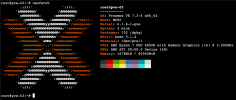root@prox3:~# lspci -D -nnk
0000:00:00.0 Host bridge [0600]: Advanced Micro Devices, Inc. [AMD] Device [1022:14b5] (rev 01)
Subsystem: Advanced Micro Devices, Inc. [AMD] Device [1022:14b5]
0000:00:00.2 IOMMU [0806]: Advanced Micro Devices, Inc. [AMD] Device [1022:14b6]
Subsystem: Advanced Micro Devices, Inc. [AMD] Device [1022:14b6]
0000:00:01.0 Host bridge [0600]: Advanced Micro Devices, Inc. [AMD] Device [1022:14b7] (rev 01)
0000:00:01.2 PCI bridge [0604]: Advanced Micro Devices, Inc. [AMD] Device [1022:14ba]
Kernel driver in use: pcieport
0000:00:01.3 PCI bridge [0604]: Advanced Micro Devices, Inc. [AMD] Device [1022:14ba]
Kernel driver in use: pcieport
0000:00:02.0 Host bridge [0600]: Advanced Micro Devices, Inc. [AMD] Device [1022:14b7] (rev 01)
0000:00:02.2 PCI bridge [0604]: Advanced Micro Devices, Inc. [AMD] Device [1022:14ba]
Kernel driver in use: pcieport
0000:00:03.0 Host bridge [0600]: Advanced Micro Devices, Inc. [AMD] Device [1022:14b7] (rev 01)
0000:00:03.1 PCI bridge [0604]: Advanced Micro Devices, Inc. [AMD] Device [1022:14cd]
Kernel driver in use: pcieport
0000:00:04.0 Host bridge [0600]: Advanced Micro Devices, Inc. [AMD] Device [1022:14b7] (rev 01)
0000:00:08.0 Host bridge [0600]: Advanced Micro Devices, Inc. [AMD] Device [1022:14b7] (rev 01)
0000:00:08.1 PCI bridge [0604]: Advanced Micro Devices, Inc. [AMD] Device [1022:14b9] (rev 10)
Kernel driver in use: pcieport
0000:00:08.3 PCI bridge [0604]: Advanced Micro Devices, Inc. [AMD] Device [1022:14b9] (rev 10)
Kernel driver in use: pcieport
0000:00:14.0 SMBus [0c05]: Advanced Micro Devices, Inc. [AMD] FCH SMBus Controller [1022:790b] (rev 71)
Subsystem: Advanced Micro Devices, Inc. [AMD] FCH SMBus Controller [1022:790b]
Kernel driver in use: piix4_smbus
Kernel modules: i2c_piix4, sp5100_tco
0000:00:14.3 ISA bridge [0601]: Advanced Micro Devices, Inc. [AMD] FCH LPC Bridge [1022:790e] (rev 51)
Subsystem: Advanced Micro Devices, Inc. [AMD] FCH LPC Bridge [1022:790e]
0000:00:18.0 Host bridge [0600]: Advanced Micro Devices, Inc. [AMD] Device [1022:1679]
0000:00:18.1 Host bridge [0600]: Advanced Micro Devices, Inc. [AMD] Device [1022:167a]
0000:00:18.2 Host bridge [0600]: Advanced Micro Devices, Inc. [AMD] Device [1022:167b]
0000:00:18.3 Host bridge [0600]: Advanced Micro Devices, Inc. [AMD] Device [1022:167c]
Kernel driver in use: k10temp
Kernel modules: k10temp
0000:00:18.4 Host bridge [0600]: Advanced Micro Devices, Inc. [AMD] Device [1022:167d]
0000:00:18.5 Host bridge [0600]: Advanced Micro Devices, Inc. [AMD] Device [1022:167e]
0000:00:18.6 Host bridge [0600]: Advanced Micro Devices, Inc. [AMD] Device [1022:167f]
0000:00:18.7 Host bridge [0600]: Advanced Micro Devices, Inc. [AMD] Device [1022:1680]
0000:01:00.0 Non-Volatile memory controller [0108]: Micron Technology Inc Device [1344:5413] (rev 03)
Subsystem: Micron Technology Inc Device [1344:1100]
Kernel driver in use: nvme
Kernel modules: nvme
0000:02:00.0 Ethernet controller [0200]: Realtek Semiconductor Co., Ltd. RTL8125 2.5GbE Controller [10ec:8125] (rev 05)
Subsystem: Realtek Semiconductor Co., Ltd. RTL8125 2.5GbE Controller [10ec:0123]
Kernel driver in use: r8169
Kernel modules: r8169
0000:03:00.0 Network controller [0280]: Intel Corporation Wi-Fi 6 AX200 [8086:2723] (rev 1a)
Subsystem: Intel Corporation Wi-Fi 6 AX200 [8086:0084]
Kernel driver in use: iwlwifi
Kernel modules: iwlwifi
0000:05:00.0 VGA compatible controller [0300]: Advanced Micro Devices, Inc. [AMD/ATI] Device [1002:1681] (rev 0a)
Subsystem: Advanced Micro Devices, Inc. [AMD/ATI] Device [1002:0124]
Kernel driver in use: vfio-pci
Kernel modules: amdgpu
0000:05:00.1 Audio device [0403]: Advanced Micro Devices, Inc. [AMD/ATI] Device [1002:1640]
Subsystem: Advanced Micro Devices, Inc. [AMD/ATI] Device [1002:1640]
Kernel driver in use: vfio-pci
Kernel modules: snd_hda_intel
0000:05:00.2 Encryption controller [1080]: Advanced Micro Devices, Inc. [AMD] VanGogh PSP/CCP [1022:1649]
Subsystem: Advanced Micro Devices, Inc. [AMD] VanGogh PSP/CCP [1022:1649]
Kernel driver in use: ccp
Kernel modules: ccp
0000:05:00.3 USB controller [0c03]: Advanced Micro Devices, Inc. [AMD] Device [1022:161d]
Subsystem: Advanced Micro Devices, Inc. [AMD] Device [1022:163a]
Kernel driver in use: xhci_hcd
Kernel modules: xhci_pci
0000:05:00.4 USB controller [0c03]: Advanced Micro Devices, Inc. [AMD] Device [1022:161e]
Subsystem: Advanced Micro Devices, Inc. [AMD] Device [1022:163a]
Kernel driver in use: xhci_hcd
Kernel modules: xhci_pci
0000:05:00.5 Multimedia controller [0480]: Advanced Micro Devices, Inc. [AMD] Raven/Raven2/FireFlight/Renoir Audio Processor [1022:15e2] (rev 60)
Subsystem: Advanced Micro Devices, Inc. [AMD] Raven/Raven2/FireFlight/Renoir Audio Processor [1022:15e2]
Kernel driver in use: snd_pci_acp6x
Kernel modules: snd_pci_acp3x, snd_rn_pci_acp3x, snd_pci_acp5x, snd_pci_acp6x
0000:05:00.6 Audio device [0403]: Advanced Micro Devices, Inc. [AMD] Family 17h (Models 10h-1fh) HD Audio Controller [1022:15e3]
Subsystem: Advanced Micro Devices, Inc. [AMD] Family 17h (Models 10h-1fh) HD Audio Controller [1022:d595]
Kernel modules: snd_hda_intel
0000:06:00.0 USB controller [0c03]: Advanced Micro Devices, Inc. [AMD] Device [1022:161f]
Subsystem: Advanced Micro Devices, Inc. [AMD] Device [1022:163a]
Kernel driver in use: xhci_hcd
Kernel modules: xhci_pci
0000:06:00.3 USB controller [0c03]: Advanced Micro Devices, Inc. [AMD] Device [1022:15d6]
Subsystem: Advanced Micro Devices, Inc. [AMD] Device [1022:15d6]
Kernel driver in use: xhci_hcd
Kernel modules: xhci_pci
0000:06:00.4 USB controller [0c03]: Advanced Micro Devices, Inc. [AMD] Device [1022:15d7]
Subsystem: Advanced Micro Devices, Inc. [AMD] Device [1022:15d7]
Kernel driver in use: xhci_hcd
Kernel modules: xhci_pci
0000:06:00.5 USB controller [0c03]: Advanced Micro Devices, Inc. [AMD] Device [1022:162e]
Subsystem: Advanced Micro Devices, Inc. [AMD] Device [1022:162e]
Kernel driver in use: thunderbolt
Kernel modules: thunderbolt




